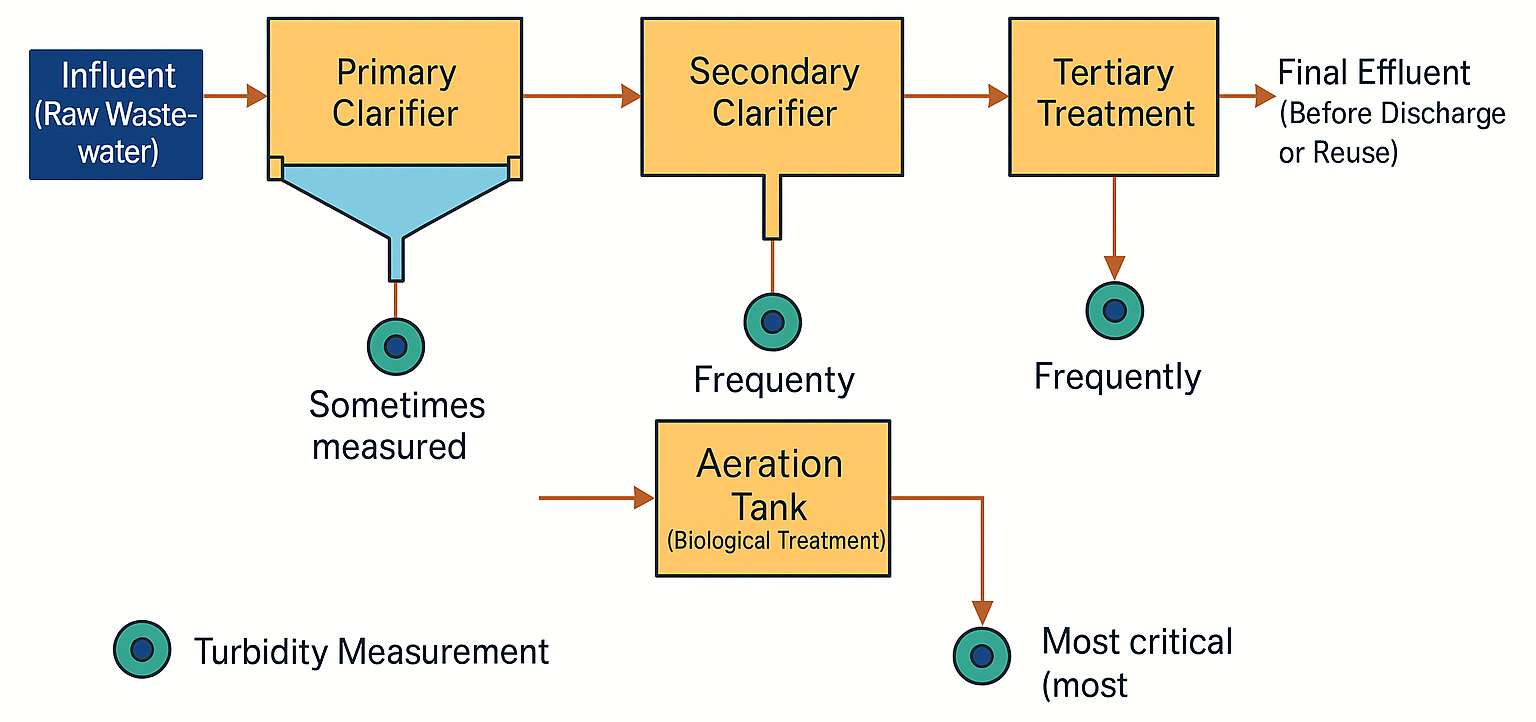Portable Turbidity Meters for Wastewater Treatment

Introduction
Turbidity measurement plays a pivotal role in assessing the quality and treatment efficiency of wastewater. Wastewater contains a variety of suspended solids—organic and inorganic matter, pathogens, and industrial discharges—that contribute to turbidity. Monitoring turbidity at various treatment stages helps ensure compliance with environmental regulations and supports process optimization. Portable turbidity meters provide a practical and reliable solution for real-time, on-site monitoring in both municipal and industrial wastewater treatment settings.
Understanding Turbidity in Wastewater
Turbidity, typically measured in Nephelometric Turbidity Units (NTU), indicates the cloudiness of water due to suspended particles. Unlike in drinking water treatment, where low turbidity is critical for health, wastewater systems focus on removing solids and pollutants to reduce turbidity before discharging effluent into the environment. Elevated turbidity in effluent can cause oxygen depletion, harm aquatic ecosystems, and indicate incomplete treatment (Metcalf & Eddy, 2014).
Working Principle of Portable Turbidity Meters
Portable turbidity meters operate on nephelometry, using a light source (usually infrared or white light) to detect scattered light from particles at a 90-degree angle. These meters are compact, battery-powered devices suited for field use. They are typically calibrated with standards and provide readings in seconds, making them ideal for spot-checks and troubleshooting.
Applications in Wastewater Treatment
1. Influent Monitoring
Measuring turbidity in incoming wastewater provides insight into the pollutant load entering the treatment plant. This data supports the adjustment of aeration rates, chemical dosing, and process sequencing.
2. Primary and Secondary Treatment Evaluation
Turbidity meters are used to evaluate the performance of primary sedimentation tanks and biological treatment processes. Consistent turbidity monitoring helps detect issues like poor sludge settling, short-circuiting, or process imbalance.
3. Tertiary Treatment and Final Effluent Monitoring
Advanced treatment processes such as filtration, membrane bioreactors (MBRs), or chemical polishing are evaluated using turbidity readings. Low turbidity in final effluent is essential before discharge or reuse to ensure environmental protection and public health (EPA, 2004).
4. Sludge Management
In sludge thickening and dewatering operations, turbidity meters assist in monitoring supernatant clarity, helping operators optimize polymer use and centrifuge settings.
5. Compliance and Reporting
Regulatory agencies often require turbidity limits for treated effluent. Portable meters allow operators to conduct frequent checks and ensure compliance with discharge permits (e.g., under National Pollutant Discharge Elimination System—NPDES in the U.S.).

Advantages of Portable Turbidity Meters
- Immediate Results: Rapid feedback enables real-time adjustments to treatment processes.
- Field Deployable: Rugged and waterproof designs make them suitable for harsh wastewater environments.
- Low Maintenance: Modern meters require minimal upkeep and provide stable performance.
- Cost-effective: Especially beneficial for small or decentralized facilities lacking continuous online instrumentation.
Limitations and Considerations
While portable turbidity meters are highly useful, users should be aware of:
- Interference from Color and Bubbles: Colored effluent or entrained air can affect accuracy.
- Calibration Requirements: Regular calibration with appropriate standards is essential.
- Sample Consistency: Proper sampling technique is critical for representative results.
Turbidity should be used alongside other parameters such as Biochemical Oxygen Demand (BOD), Total Suspended Solids (TSS), and Chemical Oxygen Demand (COD) for a comprehensive assessment.
Conclusion
Portable turbidity meters are essential tools in modern wastewater treatment systems. They enhance operational control, help detect process inefficiencies, and support environmental compliance. Their ease of use, portability, and rapid response time make them particularly valuable for routine monitoring, emergency assessments, and remote site management. As treatment standards become more stringent, the demand for reliable, on-site turbidity monitoring will only continue to grow.
References
- EPA. (2004). Guidelines for Water Reuse. United States Environmental Protection Agency, Office of Wastewater Management.
- Metcalf & Eddy, Inc. (2014). Wastewater Engineering: Treatment and Resource Recovery (5th ed.). McGraw-Hill Education.
- American Public Health Association (APHA). (2017). Standard Methods for the Examination of Water and Wastewater (23rd ed.).
- U.S. Environmental Protection Agency (USEPA). (2021). National Pollutant Discharge Elimination System (NPDES) Permitting Program. Retrieved from https://www.epa.gov/npdes





